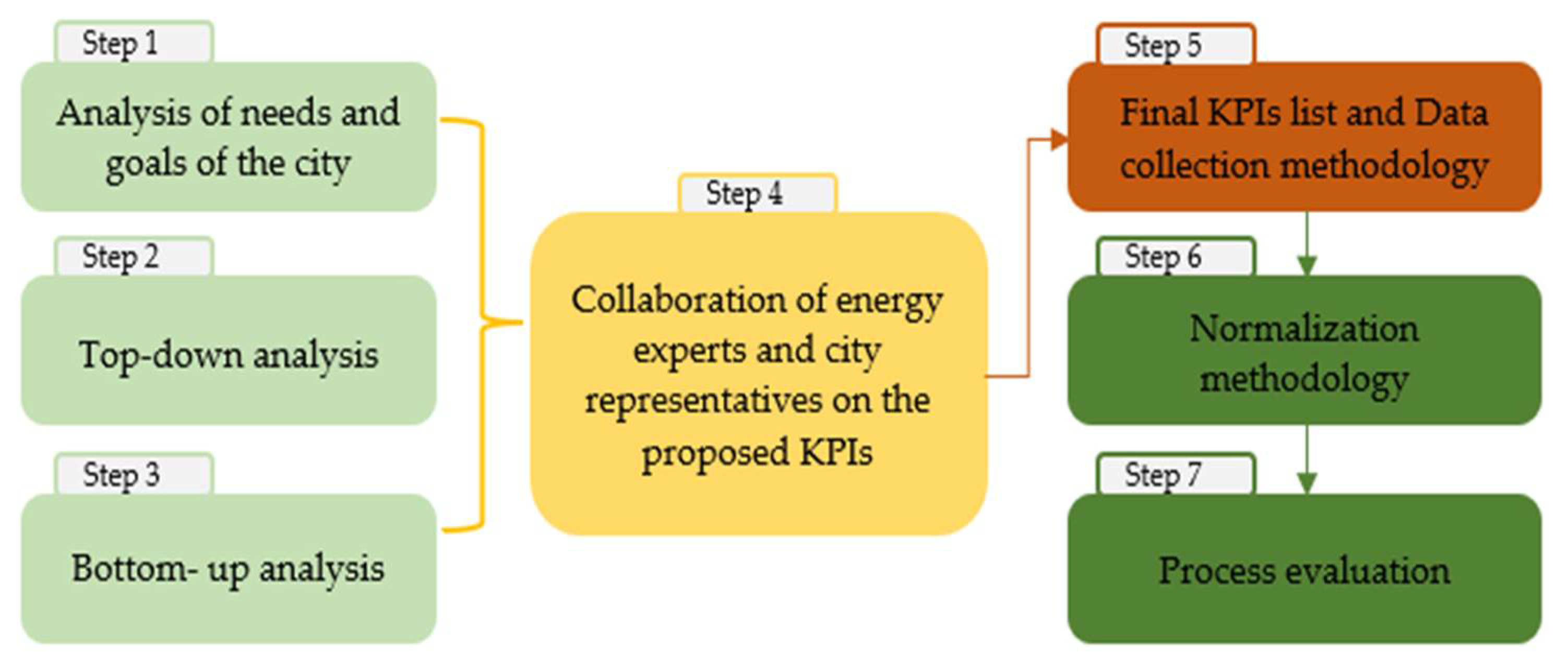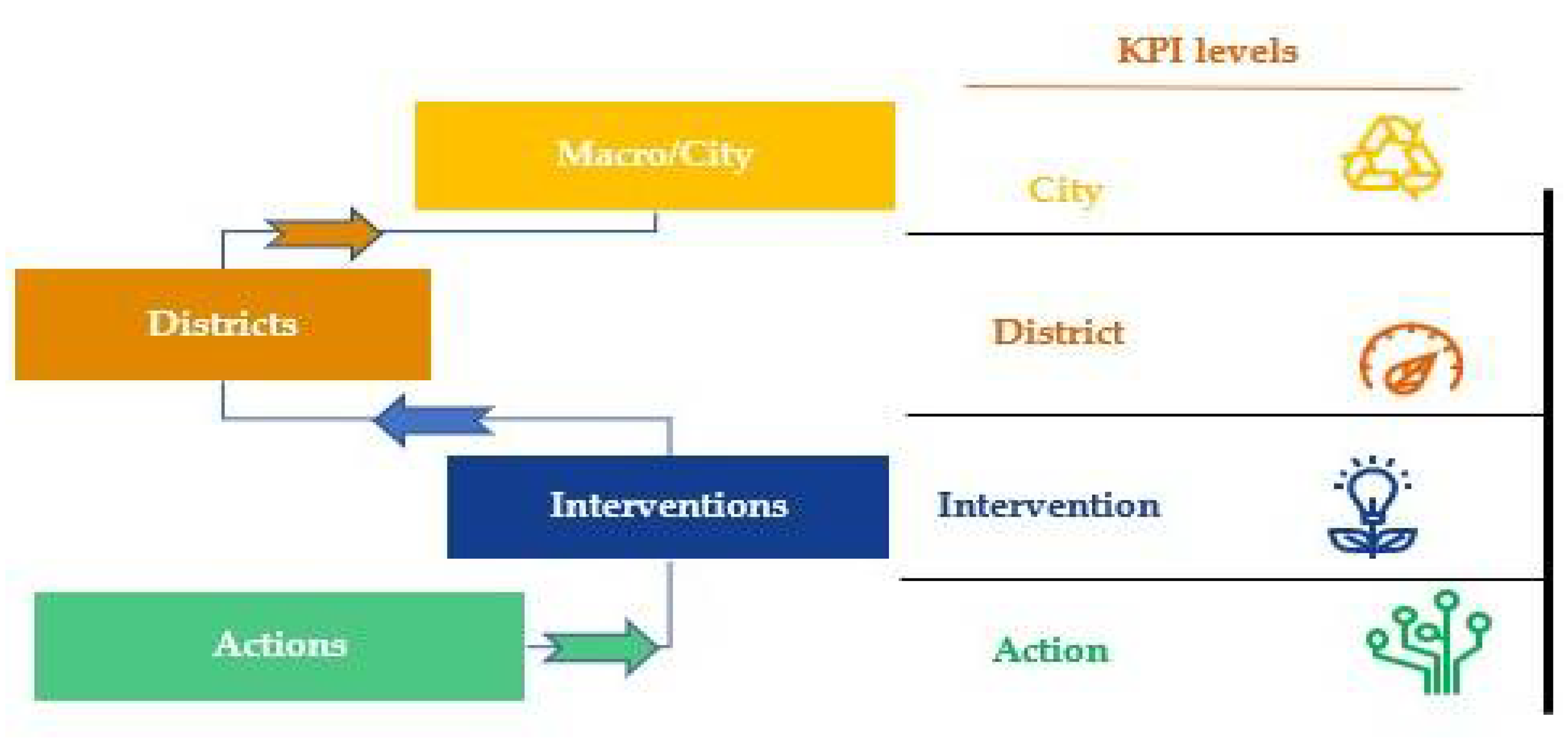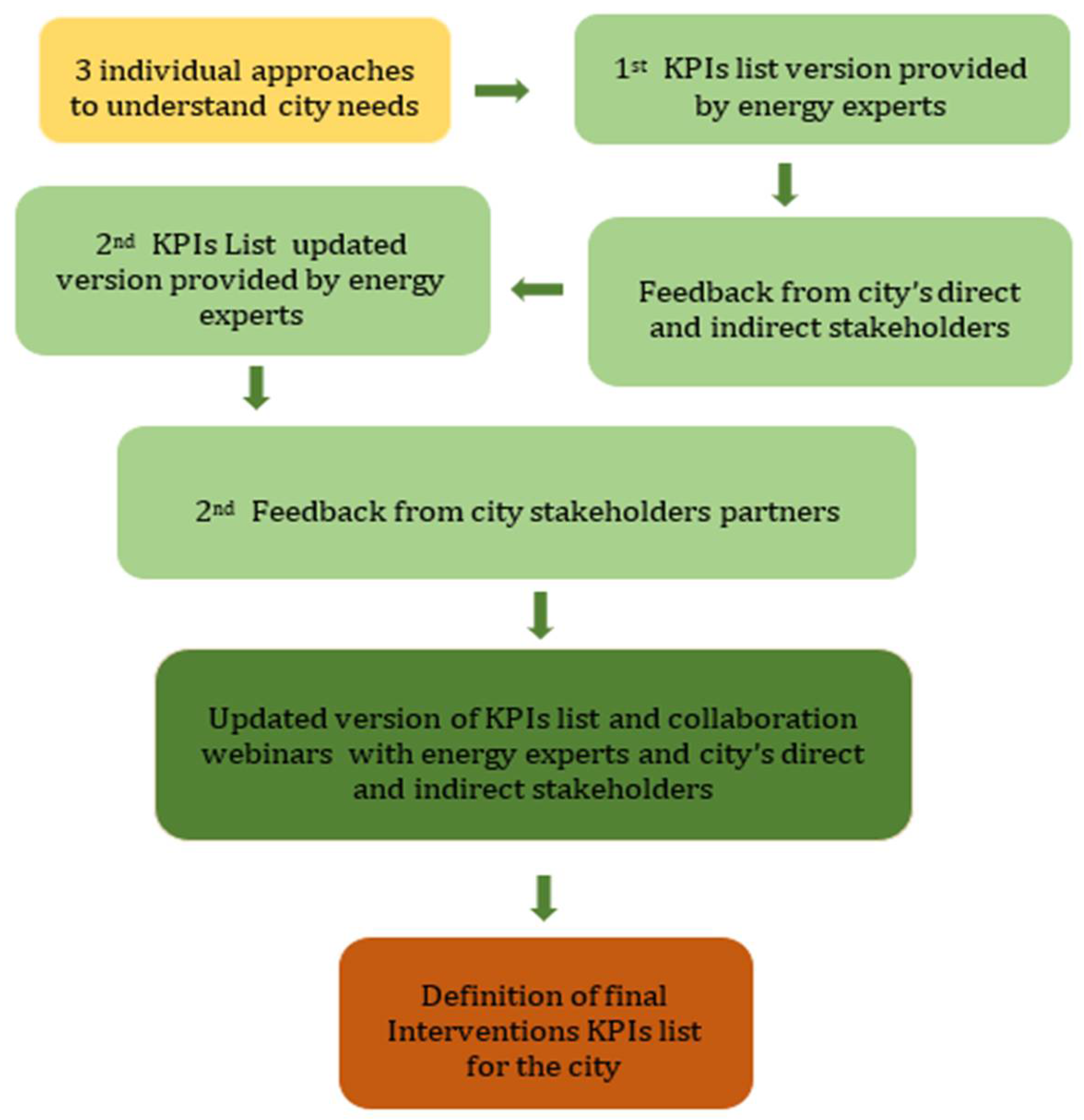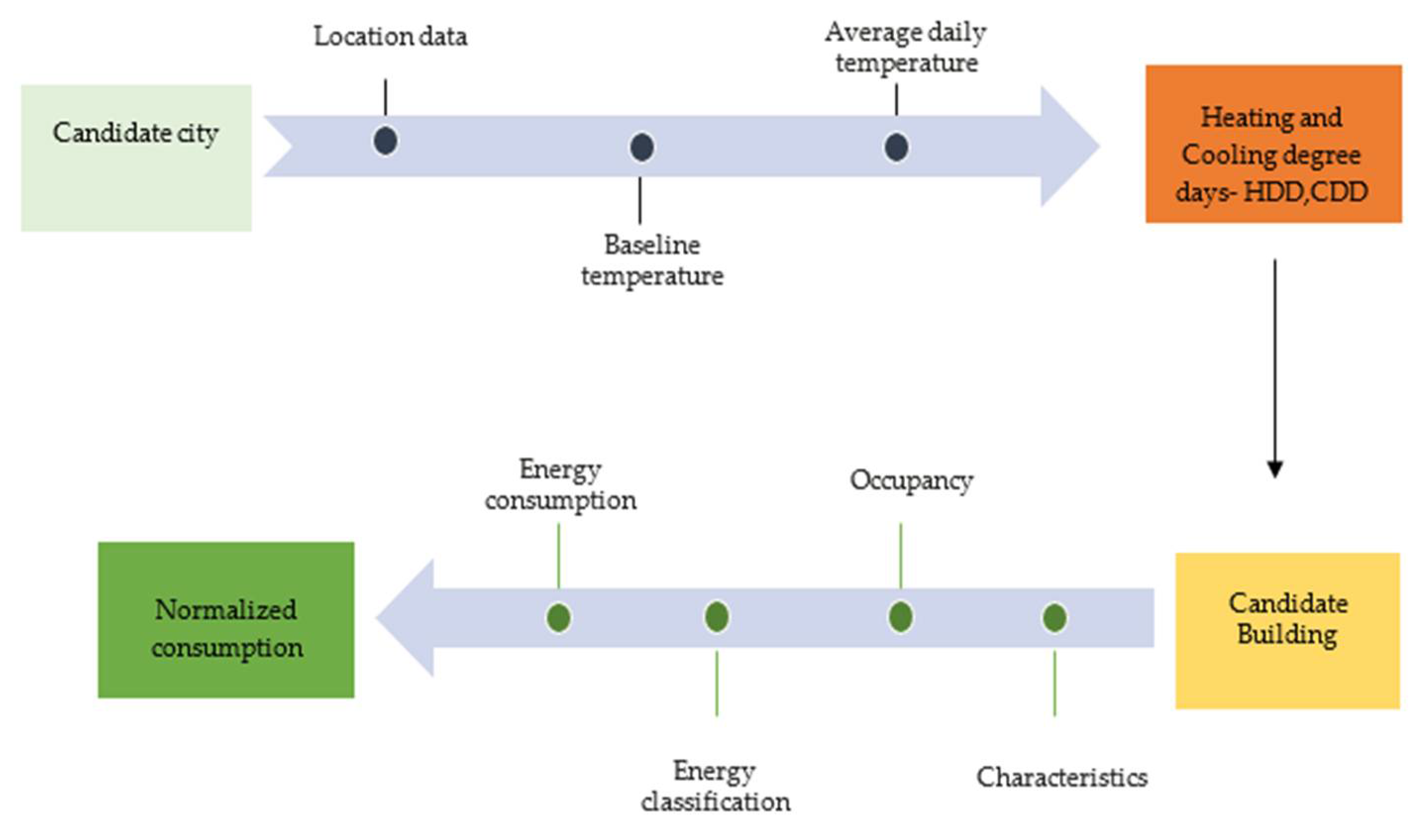A Comprehensive Methodology for Assessing the Impact of Smart City Interventions: Evidence from Espoo Transformation Process
Abstract
:1. Introduction
1.1. The Necessity of Impact Assessment
1.2. International Literature Review in Relation to Evaluation of Impact of Smart City Interventions
1.3. Relevant Work from Large Scale Projects
1.4. Purpose and Approach
- We conduct a thorough review of prominent projects that have approached impact assessment methodologies for smart cities and have reported significant lessons;
- We analyze the city implementation plan in order to have a deep understanding of the transformation strategy followed and the expected impact;
- We define a bottom-up approach for the analysis of interventions and corresponding actions that constitute the smart urban transformation;
- We aggregate and categorize a suite of KPIs that can be used in an assessment process, focusing on their distinction among categories that allow sectoral evaluation, which may, however, be integrated into a holistic energy domain assessment;
- We provide a normalization approach, detaching the particularities and exogenous characteristics of cities, both for building and non-building KPIs;
- We define a methodology for the evaluation of the process in order to highlight the findings for overcoming the obstacles that arise during the transition from the design phase to the implementation and operation; and
- We apply our developed methodology in the city of Espoo as part of the city’s planning stage towards its transformation which is anticipated until 2025.
2. Materials and Methods
2.1. Developing the Smart City Impact Assessment Methodology
2.2. Understanding a City’s Objectives
- The increased integration of renewable energy in the generation mix;
- An optimized excess heat management method for the specific city needs and existing characteristics and infrastructure;
- The optimization of local energy systems in the presence of distributed renewables, storage, demand side management and e-mobility energy resources;
- An improved energy performance of buildings and districts through human-centric building control optimization, advanced retrofitting and the optimization of district-wide electrical network operation; and
- The reduction of GHG emissions and improvement of local air quality and urban well-being.
2.3. Top-Down Analysis
2.4. Bottom-Up Analysis of Interventions and Actions
2.5. Collaboration of Energy Experts and City Representatives
2.6. Final KPIs List and Data Collection Methodology
2.7. Normalization Methodology
2.7.1. Energy-Related KPIs
2.7.2. Non-Energy Related KPIs
2.8. Process Evaluation
2.8.1. Planning Phase
2.8.2. Implementation Phase
2.8.3. Operational Phase
3. Results
Validation of the Proposed Methodology in the City of Espoo
- Kera is an underdeveloped industrial area that will be rebuilt into a new residential district with 14,000 citizens;
- The Espoonlahti district is the second largest of Espoo’s multiple city centers, with 56,000 residents, and is partially redeveloped; and
- The Leppävaara district is the largest of Espoo’s five city centers. As an already built area, the center of Leppävaara, with over 65,000 residents, is a major urban activity and transport node.
- (i)
- AThe increased integration of renewable energy in the generation mix;
- (ii)
- An optimized excess heat management method for the specific city’s needs and existing characteristics and infrastructure;
- (iii)
- The optimization of local energy systems in the presence of distributed renewables, storage, demand side management and e-mobility energy resources;
- (iv)
- An improved energy performance of buildings and districts through human-centric building control optimization, advanced retrofitting and optimization of district-wide electrical network operation; and
- (v)
- The reduction of GHG emissions and improvement of local air quality and urban well-being.
4. Discussion
5. Conclusions
Author Contributions
Funding
Data Availability Statement
Conflicts of Interest
References
- UN-DESA. United Nations Department of Economic and Social Affairs. 2018. Available online: https://www.un.org/development/desa/en/news/population/2018-revision-of-world-urbanization-prospects.html (accessed on 6 March 2020).
- Imasiku, K. Organizational Insights, Challenges and Impact of Sustainable Development in Developing and Developed Nations. In Sustainable Organizations-Models, Applications, and New Perspectives; IntechOpen: London, UK, 2021. [Google Scholar]
- Lim, Y.; Edelenbos, J.; Gianoli, A. Identifying the results of smart city development: Findings from systematic literature review. Cities 2019, 95, 102397. [Google Scholar] [CrossRef]
- Toli, A.M.; Murtagh, N. The Concept of Sustainability in Smart City Definitions. Front. Built Environ. 2020, 6, 77. [Google Scholar] [CrossRef]
- Yigitcanlar, T.; Lönnqvist, A. Benchmarking knowledge-based urban development performance: Results from the international comparison of Helsinki. Cities 2013, 31, 357–369. [Google Scholar] [CrossRef] [Green Version]
- Madlener, R.; Sunak, Y. Impacts of urbanization on urban structures and energy demand: What can we learn for urban energy planning and urbanization management? Sustain. Cities Soc. 2011, 1, 45–53. [Google Scholar] [CrossRef]
- IEA. Empowering Cities for a Net Zero Future: Unlocking Resilient, Smart, Sustainable Urban Energy Systems; Report; IEA Publications: Paris, France, 2021. [Google Scholar]
- European Commission. Directorate General for Internal Policies Policy Department: Economic and Scientific Policy Mapping Smart Cities in the EU Study; Report IP/A/ITRE/ST/2013-02; European Commission: Brussels, Belgium, 2014. [Google Scholar]
- EU Smart Cities Information System. The Making of a Smart City: Best Practices across Europe Empowering Smart Solutions for Setter Sities; European Commission: Brussels, Belgium, 2017; 256p, Available online: www.smartcities-infosystem.eu (accessed on 11 November 2021).
- Cocchia, A. Smart and Digital City: A Systematic Literature Review. In Smart City; Springer: Cham, Switzerland, 2014; pp. 13–43. [Google Scholar] [CrossRef]
- Smart Cities|European Commission. Available online: https://ec.europa.eu/info/eu-regional-and-urban-development/topics/cities-and-urban-development/city-initiatives/smart-cities_en (accessed on 6 March 2020).
- Cohen, B. What Exactly Is a Smart City. 2019. Available online: http://www.fastcoexist.com/1680538/what-exactly-is-a-smart-city (accessed on 15 April 2016).
- Andone, D.; Holotescu, C.; Grosseck, G. Learning communities in smart cities. Case studies. In Proceedings of the 2014 International Conference on Web and Open Access to Learning (ICWOAL), Dubai, United Arab Emirates, 25–27 November 2014. [Google Scholar] [CrossRef]
- Winkowska, J.; Szpilko, D.; Pejić, S. Smart city concept in the light of the literature review. Eng. Manag. Prod. Serv. 2019, 11, 70–86. [Google Scholar] [CrossRef] [Green Version]
- Apanaviciene, R.; Vanagas, A.; Fokaides, P.A. Smart building integration into a smart city (SBISC): Development of a new evaluation framework. Energies 2020, 13, 2190. [Google Scholar] [CrossRef]
- Tsolakis, N.; Anthopoulos, L. Eco-cities: An integrated system dynamics framework and a concise research taxonomy. Sustain. Cities Soc. 2015, 17, 1–14. [Google Scholar] [CrossRef]
- Anthopoulos, L. Defining Smart City Architecture for Sustainability. In Electronic Government and Electronic Participation, Proceedings of the Ongoing Research and Projects of IFIP WG 8.5 EGOV and EPart 2015, (AUGUST 2015), Thessaloniki, Greece, 30 August–2 September 2015; IOS Press: Amsterdam, The Netherlands, 2015; pp. 140–147. [Google Scholar] [CrossRef]
- Nam, T.; Pardo, T.A. Conceptualizing smart city with dimensions of technology, people, and institutions. In Proceedings of the 12th Annual International Digital Government Research Conference: Digital Government Innovation in Challenging Times, College Park, MD, USA, 12–15 June 2011; pp. 282–291. [Google Scholar] [CrossRef]
- Calvillo, C.F.; Sánchez-Miralles, A.; Villar, J.; Martín, F. Impact of EV penetration in the interconnected urban environment of a smart city. Energy 2017, 141, 2218–2233. [Google Scholar] [CrossRef] [Green Version]
- Meijer, A.; Bolívar, M.P.R. Governing the smart city: A review of the literature on smart urban governance. Int. Rev. Adm. Sci. 2016, 82, 392–408. [Google Scholar] [CrossRef]
- IMD Smart City Index 2019—IMD Report. Available online: https://www.imd.org/research-knowledge/reports/imd-smart-city-index-2019/ (accessed on 5 January 2021).
- Smart City Digital Ecosystem|Shaping Europe’s Digital Future. Available online: https://digital-strategy.ec.europa.eu/en/policies/smart-city-digital-ecosystem (accessed on 11 November 2021).
- Caird, S.P.; Hallett, S.H. Towards evaluation design for smart city development. J. Urban Des. 2018, 24, 188–209. [Google Scholar] [CrossRef]
- Komninos, N.; Tsampoulatidis, I.; Kakderi, C.; Nikolopoulos, S.; Kompatsiari, I. Projects for intelligent and smart cities: Technology and innovation transforming city ecosystems. Preprints 2021, 2021080080. [Google Scholar] [CrossRef]
- Komninos, N.; Bratsas, C.; Kakderi, C.; Tsarchopoulos, P. Smart City Ontologies: Improving the effectiveness of smart city applications. J. Smart Cities 2016, 1, 31–46. [Google Scholar] [CrossRef] [Green Version]
- Dameri, R.P.; Garelli, R. Measuring Business Benefits and Performance in Smart Cities. In Proceedings of the European Conference on Innovation and Entrepreneurship, (Ecie 2014), Belfast, UK, 18–19 September 2014; pp. 137–144. [Google Scholar]
- Dameri, R.P. Urban Smart Dashboard. Measuring Smart City Performance. In Smart City Implementation; Springer: Cham, Switzerland, 2017; pp. 67–84. [Google Scholar] [CrossRef]
- Kourtzanidis, K.; Angelakoglou, K.; Apostolopoulos, V.; Giourka, P.; Nikolopoulos, N. Assessing impact, performance and sustainability potential of smart city projects: Towards a case agnostic evaluation framework. Sustainability 2021, 13, 7395. [Google Scholar] [CrossRef]
- Dameri, R.P. Urban Tableau de Bord: Measuring Smart City Performance. Lect. Notes Inf. Syst. Organ. 2015, 5, 173–180. [Google Scholar] [CrossRef]
- Tanda, A.; de Marco, A.; Rosso, M. Evaluating the impact of smart city initiatives the torino living lab experience. In Proceedings of the 6th International Conference on Smart Cities and Green ICT Systems, Porto, Portugal, 22–24 April 2017; pp. 281–286. [Google Scholar] [CrossRef]
- ISO Standard No 37101; Sustainable Development in Communities—Management System for Sustainable Development—Requirements with Guidance for Use . International Organization for Standardization: Geneva, Switzerland, 2016; p. 32. Available online: https://www.iso.org/standard/61885.html (accessed on 11 November 2021).
- ISO Standard No. 37122:2019; Sustainable Cities and Communities—Indicators for Smart Cities. International Organization for Standardization: Geneva, Switzerland, 2019. Available online: https://www.iso.org/standard/69050.html (accessed on 11 November 2021).
- Huovila, A.; Bosch, P.; Airaksinen, M. Comparative analysis of standardized indicators for Smart sustainable cities: What indicators and standards to use and when? Cities 2019, 89, 141–153. [Google Scholar] [CrossRef]
- Sojda, A.; Wolny, M. The Impact of Standardisation Method on Smart City Ranking. Sci. Pap. Silesian Univ. Technol. Organ. Manag. Ser. 2020, 2020, 83–94. [Google Scholar] [CrossRef]
- Akande, A.; Cabral, P.; Gomes, P.; Casteleyn, S. The Lisbon ranking for smart sustainable cities in Europe. Sustain. Cities Soc. 2019, 44, 475–487. [Google Scholar] [CrossRef]
- Lazaroiu, G.C.; Roscia, M. Definition methodology for the smart cities model. Energy 2012, 47, 326–332. [Google Scholar] [CrossRef]
- Debnath, A.K.; Chin, H.C.; Haque, M.M.; Yuen, B. A methodological framework for benchmarking smart transport cities. Cities 2014, 37, 47–56. [Google Scholar] [CrossRef] [Green Version]
- Marketplace of the European Innovation Partnership on Smart Cities and Communities. Available online: https://eu-smartcities.eu/ (accessed on 26 March 2020).
- CITYKeys-Home. Available online: http://www.citykeys-project.eu/ (accessed on 9 March 2020).
- About the Smart Cities Information System (SCIS)|Smartcities Information System. Available online: https://smartcities-infosystem.eu/content/about-smart-cities-information-system-scis (accessed on 20 January 2020).
- Home|CIVITAS. Available online: https://civitas.eu/ (accessed on 11 November 2021).
- Triangulum|The Three Point Project Triangulum Is One of Currently Nine European Smart Cities and Communities Lighthouse Projects, Set to Demonstrate, Disseminate and Replicate Solutions and Frameworks for Europe’s Future Smart Cites. Available online: https://triangulum-project.eu/ (accessed on 11 November 2021).
- Marijuán, G.; Etminan, G.; Möller, S. Smart Cities Information System-Key Performance Indicator Guide Version 2.0, EU SCIS; 1 February 2017; ENER C2/2013-463/S12.691121. Available online: https://www.smartcities-infosystem.eu/sites/default/files/document/scis_kpi_guide.pdf (accessed on 3 March 2019).
- Rooijen, N.; van Nesterova, T. Deliverable 4.10: Applied Framework for Evaluation in CIVITAS PLUS II; Civitas Wiki Project, WP4, May 31 2013, Grant Agreement No.: 296081; Civitas Wiki: London, UK, 2013. [Google Scholar]
- Angelakoglou, K.; Nikolopoulos, N.; Giourka, P.; Svensson, I.-L.; Tsarchopoulos, P.; Tryferidis, A.; Tzovaras, D. A Methodological Framework for the Selection of Key Performance Indicators to Assess Smart City Solutions. Smart Cities 2019, 2, 269–306. [Google Scholar] [CrossRef] [Green Version]
- About the Covenant of Mayors. Available online: https://www.covenantofmayors.eu/about/covenant-initiative/origins-and-development.html (accessed on 11 November 2021).
- Sparcs|Sparcs. Available online: https://www.sparcs.info/ (accessed on 11 November 2021).
- Hukkalainen, M.; Zarrin, F.; Klobut, K.; Lindholm, O.; Ranta, M.; Hajduk, P.; Vainio-Kaila, T.; Wanne, E.; Tartia, J.; Horn, H.; et al. Deliverable 3.1: Detailed Plan of the Espoo Smart City Lighthouse Demonstrations; SPARCS project, Grant Agreement No.: 864242. 2020. Available online: https://www.sparcs.info/about/deliverables/d301-detailed-plan-espoo-smart-city-lighthouse-demonstrations (accessed on 11 November 2021).
- Huber, M.; André Knottnerus, J.; Green, L.; Van Der Horst, H.; Jadad, A.R.; Kromhout, D.; Leonard, B.; Lorig, K.; Loureiro, M.I.; van der Meer, J.W.M.; et al. How should we define health? BMJ 2011, 343, d4163. [Google Scholar] [CrossRef] [PubMed] [Green Version]




| SCIS | CITYkeys | CIVITAS | Triangulum | |
|---|---|---|---|---|
| Number of indicators | 38 | 101 | 30 | 79 |
| Type of indicators | Impact | Output, Impact | Process, Impact | Impact |
| Assessment scale | City, District, Building | City, Project | City | Project |
| Impact categories covered | Technical, Environmental, Economic, ICT, Mobility | People, Planet, Prosperity, Governance, Propagation | Global Environment, Quality of life, Economic success, Mobility system performance | Energy, Transport, Socioeconomic, Citizen engagement, ICT |
| Parties Involved | Stage of Involvement |
|---|---|
| Direct city stakeholders (typically including employees, decision makers, technical and financial departments, project managers) | Step 1 Step 3 Step4 Step5 Step7 |
| Indirect city stakeholders (external stakeholders, subcontractors, 3rd party technology partners, project managers) | Step 1 Step 3 Step4 Step5 Step7 |
| Energy experts (engineers, energy supply scientists, data scientists, environmental scientists) | Step 1 Step2 Step 3 Step4 Step5 Step6 Step7 |
| Impacts | Impact Description | Key Performance Indicators | Unit |
|---|---|---|---|
| General impacts | Return of investments, payback time, debt service coverage ratio, carbon emission reduction, res share, energy savings | Return of Investment (ROI) | % |
| Payback time | Years | ||
| Debt Service Coverage Ratio | % | ||
| Total electricity demand reduction | Wh | ||
| Total heating demand reduction | Wh | ||
| Reduction of CO2-eq emissions | Tones/year | ||
| Share of RES increase | % | ||
| Impact 1 | Meeting global and EU climate mitigation and adaptation goals and national and/or local energy air quality and climate targets | Reduction of CO2-eq emissions | Tones/year |
| Air quality | Ppm | ||
| Impact 2 | Increase of share of renewable energy, excess heat recovery, appropriate storage solutions and their integration into the energy system | Share of RES increase | % |
| Excess Heat recovery ratio | % | ||
| Increase of integrated systems share | % | ||
| Energy Storage Increase | % | ||
| Impact 3 | Rollout of Positive Energy Districts (PED) | Decrease of energy import share | % |
| Impact 4 | Improvement of energy efficiency, district level self-consumption optimization and energy curtailment reduction | Increase of Citizens participation in market | % |
| Peak load (electricity) reduction | % | ||
| Peak load (heating) reduction | % | ||
| Self-consumption rate Increase | % | ||
| Onsite Energy Ratio (OER) | % | ||
| Impact 5 | Increase of E-mobility solutions | EV car sharing rate increase | % |
| Increase of EVs share in local transportation | % | ||
| Transport behavior | |||
| Increase of EV (smart) charging points | % | ||
| Utilization of charging stations | ∑Wh charged | ||
| Impact 6 | Air quality improvement | Reduction of CO2 and NOx emissions, small particulates and volatile hydrocarbons | % |
| Impact 7 | Maximization of the replicability potential | Development and implementation of a replication strategy | Number of replicated solutions |
| Impact 8 | Increase citizens’ quality of life, health and well-being | Increase citizens’ quality of life health and well-being | % |
| Interventions Espoo | Number of Actions | Key Performance Indicators | Unit |
|---|---|---|---|
| E1—Solutions for positive energy blocks | 6 | Onsite energy ratio (OER) | % |
| E2—Boosting E-mobility uptake | 3 | kWh charged to EVs | Wh |
| Number of different EV charging stations | Number | ||
| E3—Engaging users | 3 | Number of people aware of existing solutions | Number |
| Did you feel that you had a real possibility to impact current situation/change? | Likert scale | ||
| E4—Smart business models | 1 | How well does the business model(s) cover the four lenses of innovation (desirability, feasibility, viability and sustainability)? | Likert scale |
| E5—Solutions for positive energy blocks | 3 | Percentage of locally produced energy (heat, cool, electricity) compared to baseline | % |
| Percentage of onsite RES compared to demand | % | ||
| Percentage of onsite RES compared to max potential | % | ||
| E6—ICT for positive energy blocks | 3 | Percentage of flexibility compared to baseline | % |
| Prediction accuracy of flexibility | % | ||
| E7—New E-mobility hub | 3 | Percentage of flexibility compared to baseline | % |
| Prediction accuracy of flexibility | % | ||
| E8—Engaging users | 3 | Number of people reached in total | Number |
| Number of citizens who contributed to co-created solutions | Number | ||
| E9—Smart business models | 1 | Citizens interest in new business models that can be developed and shared as a common vision for value-added proposals, revenue generation and required results | Likert scale |
| E10—Solutions for positive energy blocks | 3 | On-site energy ratio | % |
| Number of early-stage solutions investigated | Number | ||
| E11—Engaging users | 1 | Targeted share of bicycle and pedestrian mobility mode | Likert scale |
| E12—ICT for positive energy blocks | 3 | Model developed and cost-benefit analysis completed for blockchain technology | Number |
| E13—E-mobility in Kera district | 2 | Estimated share of vehicle: km by chargeable vehicles, Hybrid Electric Vehicle (HEV), Battery Electric vehicle (BEV), excl. bicycles | % |
| E14—New economy/smart governance models | 1 | Number of stakeholders who contributed to co-created business models | Number |
| Percentage of stakeholder satisfaction | Likert scale | ||
| E15—Virtual power plant | 2 | Number of flexible loads: typology/type, capacity, response delay | Number |
| Number of blockchain platforms | Number | ||
| E16—Smart heating | 1 | Number of buildings connected to smart heating service | Number |
| E17—Virtual twin | 2 | Increased number of persons using Espoo 3D city model | Number |
| Number of innovative energy technologies incorporated in virtual twin for simulation purposes | Number | ||
| E18—EV charging effects to grid | 1 | How much lower is the peak power demand when using the developed charging strategies compared to the normal case? | kWh |
| Number of innovative energy technologies incorporated in virtual twin for simulation purposes | Number | ||
| E19—Sustainable lifestyle | 2 | Healthy lifestyle indicators [49]: Physical health Emotional health Financial health | Likert scale |
| E20—District development | 1 | Increase of smart energy infrastructures | (Number) |
| E21—Air quality | 1 | PM10NOx | Ppm |
| E22—Co-creation for positive energy district development | 2 | Number of relevant stakeholders engaged | (Number) |
| Acceptance of smart city Espoo concept | Likert scale | ||
| E23—New economy/smart business models | 2 | Number of new projects generated and volume of funding | (Number) |
Publisher’s Note: MDPI stays neutral with regard to jurisdictional claims in published maps and institutional affiliations. |
© 2022 by the authors. Licensee MDPI, Basel, Switzerland. This article is an open access article distributed under the terms and conditions of the Creative Commons Attribution (CC BY) license (https://creativecommons.org/licenses/by/4.0/).
Share and Cite
Ntafalias, A.; Papadopoulos, G.; Papadopoulos, P.; Huovila, A. A Comprehensive Methodology for Assessing the Impact of Smart City Interventions: Evidence from Espoo Transformation Process. Smart Cities 2022, 5, 90-107. https://doi.org/10.3390/smartcities5010006
Ntafalias A, Papadopoulos G, Papadopoulos P, Huovila A. A Comprehensive Methodology for Assessing the Impact of Smart City Interventions: Evidence from Espoo Transformation Process. Smart Cities. 2022; 5(1):90-107. https://doi.org/10.3390/smartcities5010006
Chicago/Turabian StyleNtafalias, Aristotelis, Giorgos Papadopoulos, Panagiotis Papadopoulos, and Aapo Huovila. 2022. "A Comprehensive Methodology for Assessing the Impact of Smart City Interventions: Evidence from Espoo Transformation Process" Smart Cities 5, no. 1: 90-107. https://doi.org/10.3390/smartcities5010006
APA StyleNtafalias, A., Papadopoulos, G., Papadopoulos, P., & Huovila, A. (2022). A Comprehensive Methodology for Assessing the Impact of Smart City Interventions: Evidence from Espoo Transformation Process. Smart Cities, 5(1), 90-107. https://doi.org/10.3390/smartcities5010006








